Ever since Gary Neville retired in 2011, Manchester United have had their troubles in finding a replacement at right-back. Although Antonio Valencia was solid considering his positional change, he still was not one of the best in his position. Now though, United have one of the best fullbacks in the Premier League in Aaron Wan-Bissaka.
I do not need to talk about his defensive contributions, as it is well known that Wan Bissaka is one of the best full-backs in Europe in the defensive side of the game. However, this tactical analysis will be assessing the defenders offensive problems he’s had throughout the past season at United and how the likely signing of a right-winger to the club will bring improvement to Wan Bissaka’s offensive output.
Current right-wing options
Wan-Bissaka has had an impressive season with the Red Devils and could arguably get their Player of the Season award. Yet the expectations at a club like Manchester United mean that he will need to start contributing highly in the attacking phases too.
With only two assists in 2331 Premier League minutes, it is clear that the right-back has had trouble on the offensive front. Although there are other factors which affect his low offensive output, the lack of a right-winger to support him in attack and attacking transition has been a clear reason for the low output Wan-Bissaka has had offensively.
Manchester United have opted for either Daniel James, Juan Mata or Mason Greenwood on the right flank throughout the season, none of which are natural right-wingers and often are not in good positions to help the right-back offensively.
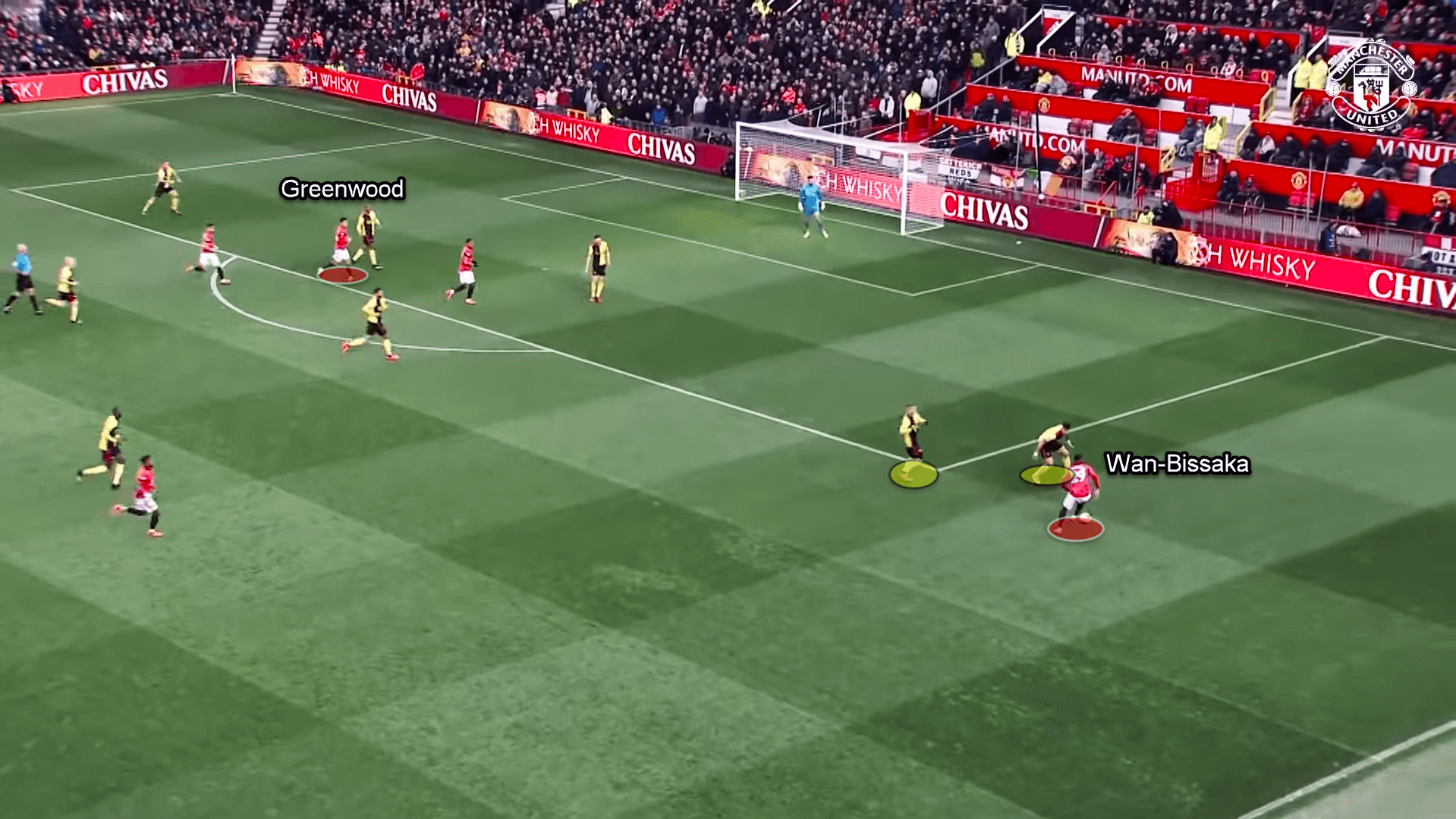
The image above is from a Manchester United game where Greenwood was operating as the right-winger. Although, Greenwood is naturally a striker and drifts into central areas a lot when playing, as highlighted above. When drifting into these areas, Greenwood will usually not drag the fullback inside with him and subsequently creates a difficult situation for Wan-Bissaka out wide, who in this situation is now overloaded in a 1v2 on the right flank.
Considering Wan-Bissaka is at his best offensively when linking up with players or being able to dribble into space, being in a situation like above makes it unlikely the full-back will be effective.
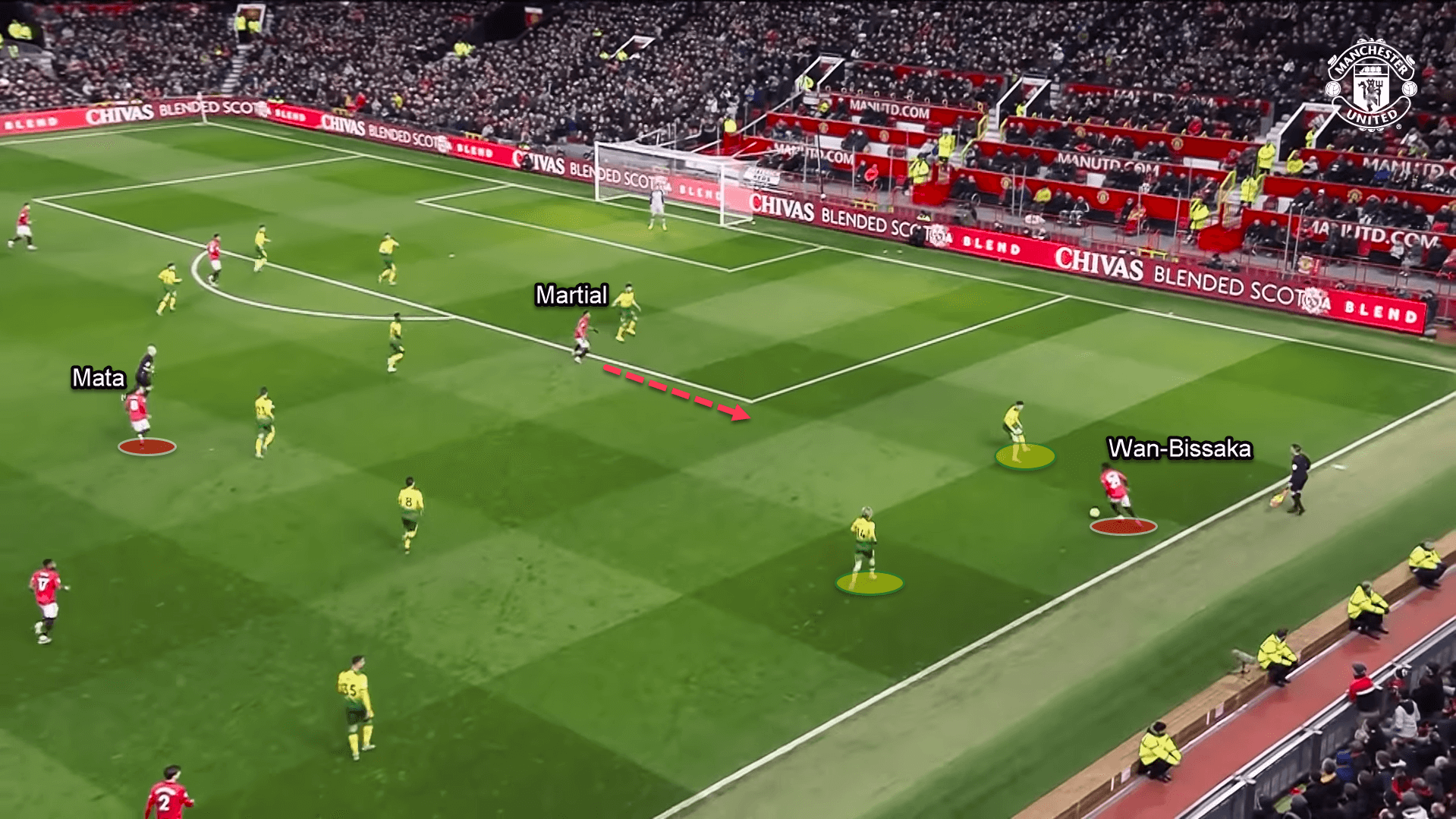
This time, the image above shows a game where Mata was meant to be on the right-side, yet, he is highlighted in a central position; again meaning Wan-Bissaka is in a 1v2 situation. Anthony Martial has to drift across to create a passing option but this just means there is one less body for the right-back to potentially cross towards.
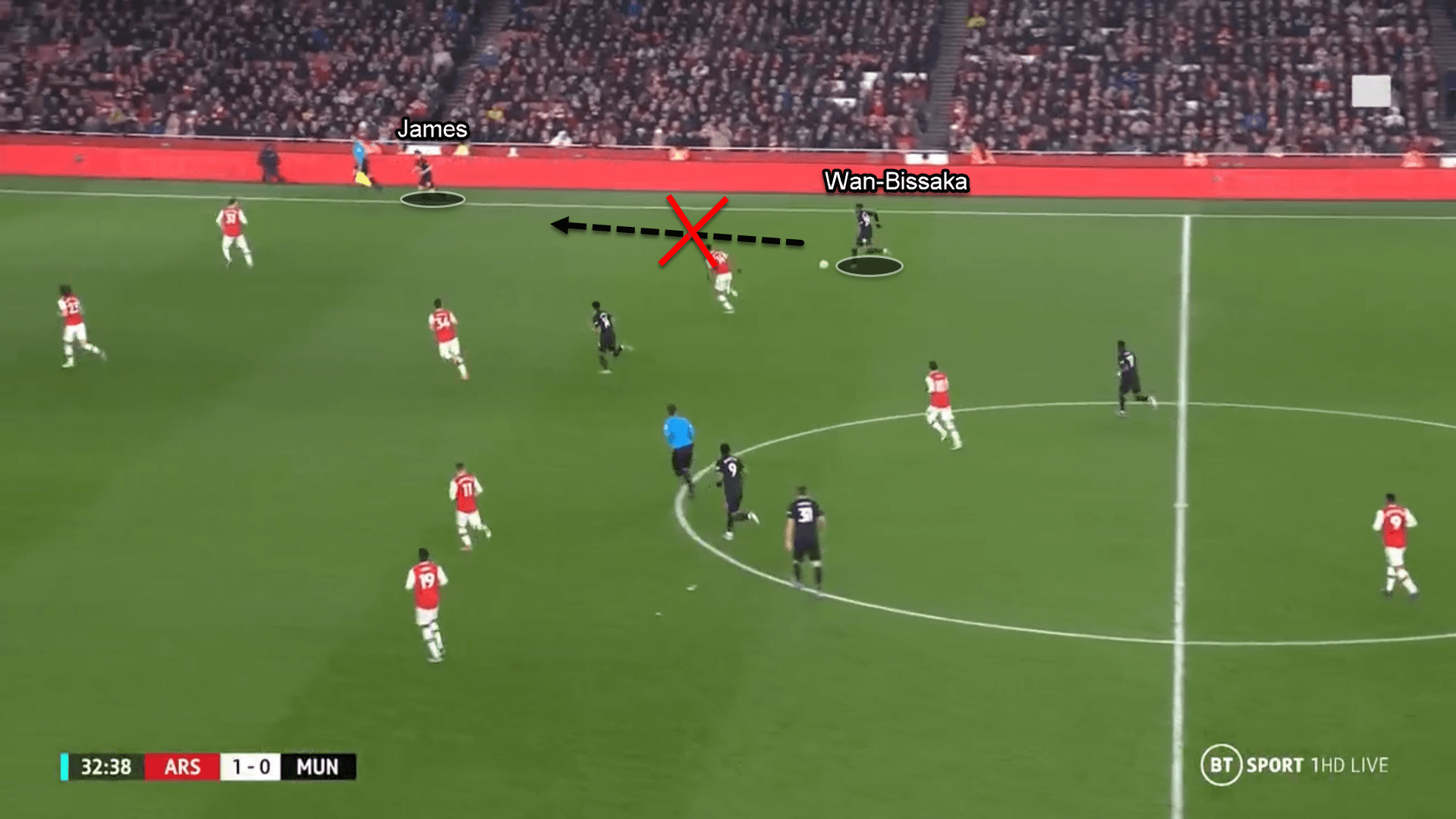
Now the image above shows James operating in the right-wing role. Although the Welshman is at least on the right flank, it is obvious he prefers to come from the left through his lack of movement. By hugging the touchline like he is and not even making a run down the line, James is blocking the lane which Wan-Bissaka was already trying to progress into. Although he is a passing option, it will not help United progress the ball or help Wan-Bissaka receive the ball in a better offensive position.
Wan-Bissaka’s offensive assets
Before analysing what a right-winger will bring, I will look at Wan Bissaka’s main assets in the attacking side of his game, as well as the aspects which need improving. Here are his assets.
He is an impressive dribbler of the ball and completes an average of 4.38 dribbles per 90. His long legs allow him to keep good control of the ball, while he also has a good body feint in order to get past opposition.

The images above show the dribbling ability that the defender has. Wan-Bissaka uses a body feint to make it seem like he is carrying the ball inwards, but instead dribbles on the outside and releases the pass to James in space for him to cross.
Wan Bissaka’s dribbling also helps him in his progressive runs which is one of his strengths, he makes 2.19 progressive runs per 90, but once he makes his runs forward there are usually limited options due to the lack of positional awareness of the right-wingers at Manchester United as shown before. The right-back has the pace, passing ability and close control to be able to progress the ball on the flank more if he is given the support by his winger.
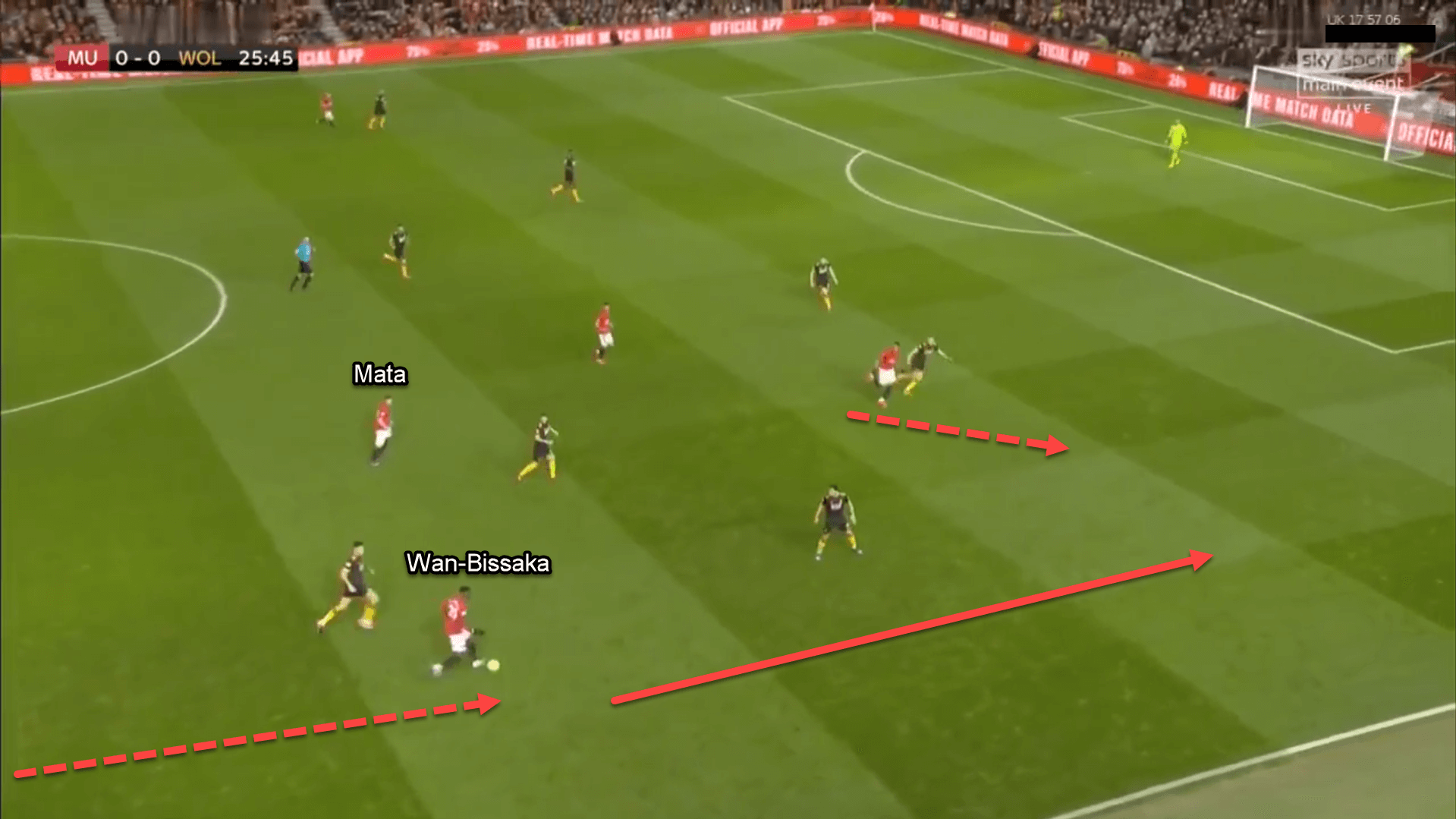
In the image above, Wan-Bissaka has made a solid progressive run down the right flank, he then plays a pass down the line to Martial as again Mata is not in a wide position for Wan-Bissaka to link up with or to drag a wide opposition player away to create more space for the right-back to drive into.
Another strength Wan-Bissaka has going forward is his passing ability. He plays an average of 3.36 passes into the final third per 90 which is in the top 29% of fullbacks across Europe’s top five leagues, a lot of these passes are infield ones to the striker or players operating in half-spaces or between the opposition lines, he prefers to play these kinds of passes and the lack of players who have operated in these areas for United until Bruno Fernandes joined makes the statistic more impressive.
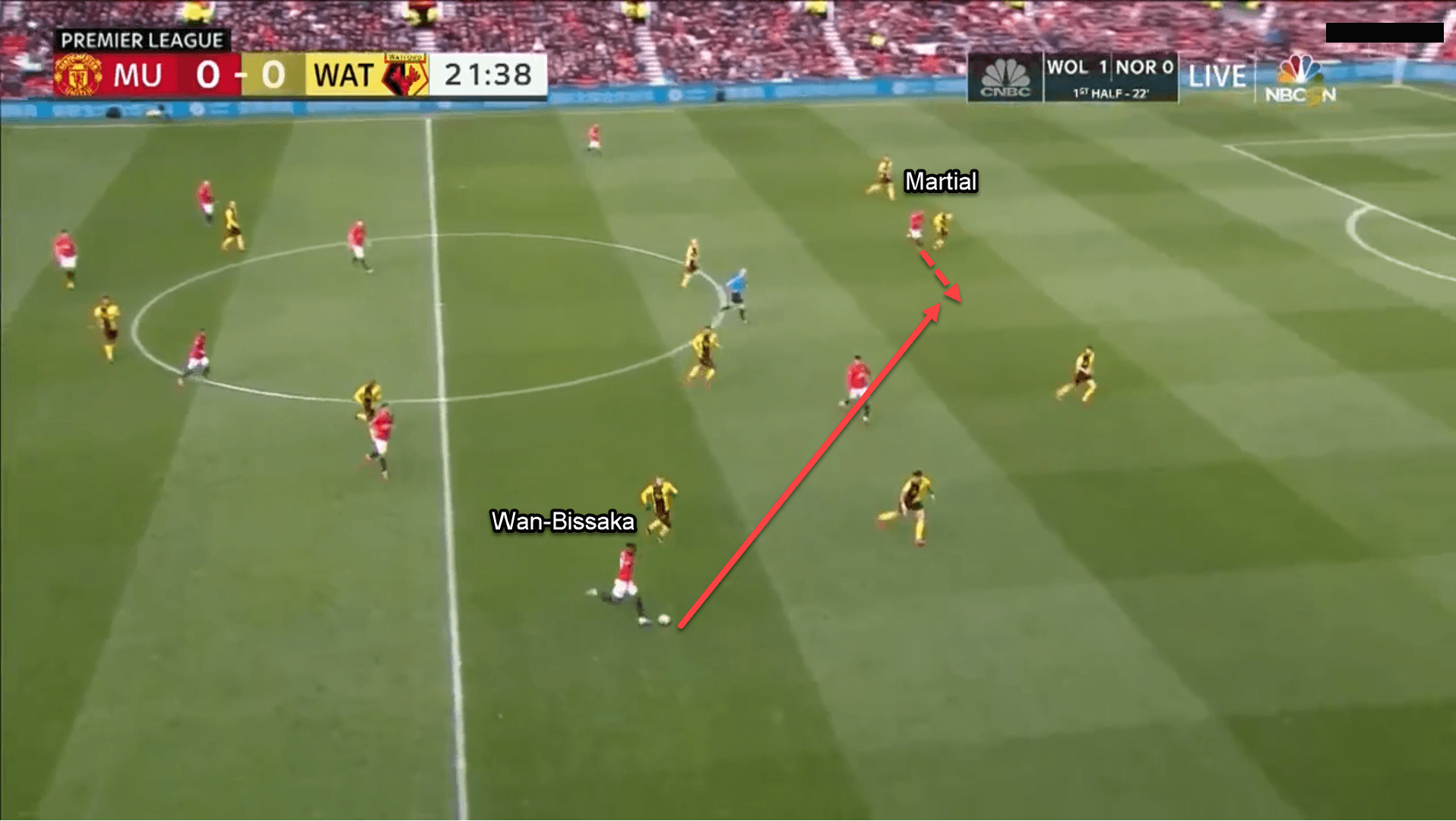
A typical example of the passes Wan Bissaka likes to play is shown above. He is attacking the right-side and plays a firm pass inside into Martial’s feet. This type of pass can be very beneficial to a winger who likes to operate between-the-lines or operate in the half-spaces.
Wan-Bissaka has clear offensive qualities but in order to maximise his output, he needs the support of a top right-winger.
Wan-Bissaka’s offensive troubles
However, Wan-Bissaka is definitely not a finished product in the attacking side of his game and even though his wingers do not benefit him much, he still has his own areas to work on.
His poor balance when crossing the ball leads to inconsistencies in his deliveries. His crossing accuracy is only 27.5% and his crosses are often lofted ones without much power in them due to his lack of balance. This makes it more difficult for the receiver of the cross to generate power on their headers too. Also it makes it easier for goalkeepers to come and claim a cross.
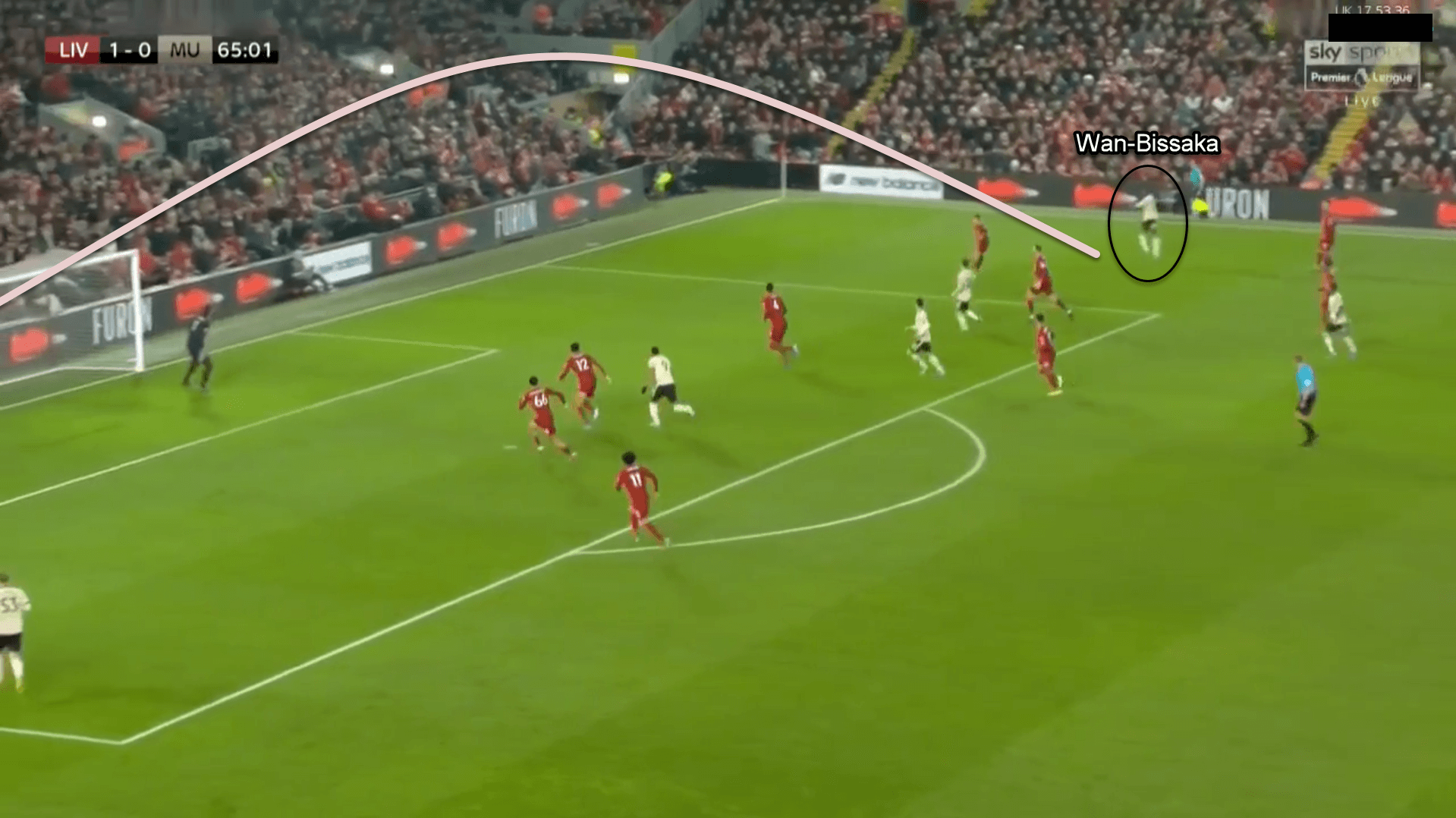
The above example against Liverpool shows how his poor balance can lead to a failed cross. Wan-Bissaka initially does well to get in space to cross the ball in, but his lack of balance means that he is leaning back when making the connection with the ball and results in it going straight out for a goal kick.
Also, Wan-Bissaka is often hesitant and not direct enough in his off-the-ball runs. Even though he is not always helped by the wingers positioning. When there is an opportunity to move into space or overlap, he can be hesitant to make these runs.
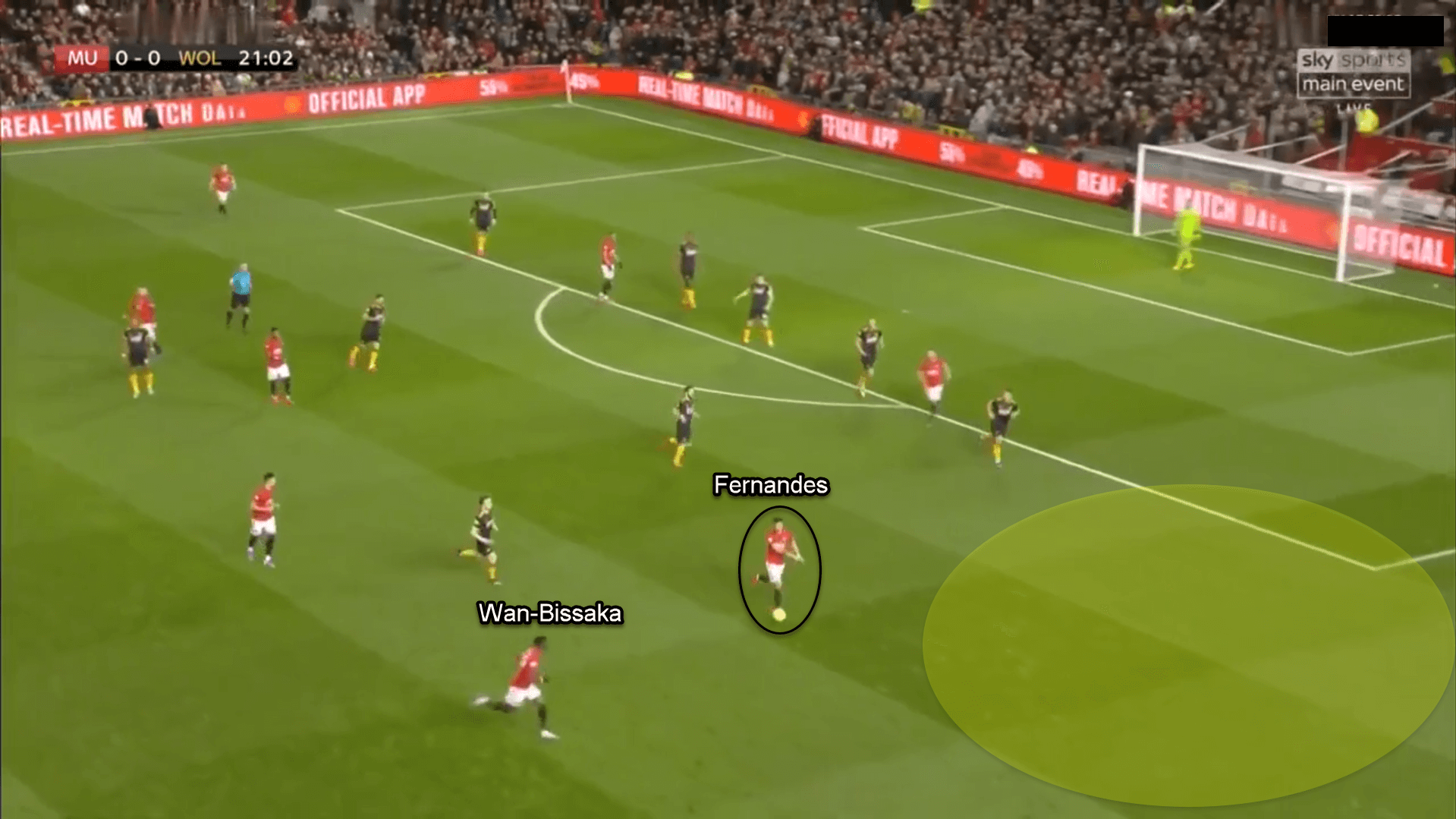
The hesitance Wan-Bissaka has in his off-the-ball runs is clearly shown in the image above. Fernandes is circled telling him where he should be; although he does receive the ball after running; if he had spotted this space earlier and drove into it he would have received the ball in a more advanced and dangerous position to play a cross into the box.
However, Wan-Bissaka can refine these aspects of his game and he has already looked more consistent with his crossing in the second half of the season, with both of his assists against Newcastle and Chelsea coming after Christmas.
What a right-winger will offer Wan-Bissaka
Considering the increasing likeliness of the transfer of Jadon Sancho to Manchester United, I will be using him as an example of what a right-winger will offer Wan-Bissaka; although other top wingers will offer similar kinds of benefits to Wan-Bissaka that Sancho would.
Although the Dortmund winger seems more comfortable coming from the left-hand side, his high footballing IQ means that he can easily play the role on the right as he has the majority of the season for Borussia Dortmund.
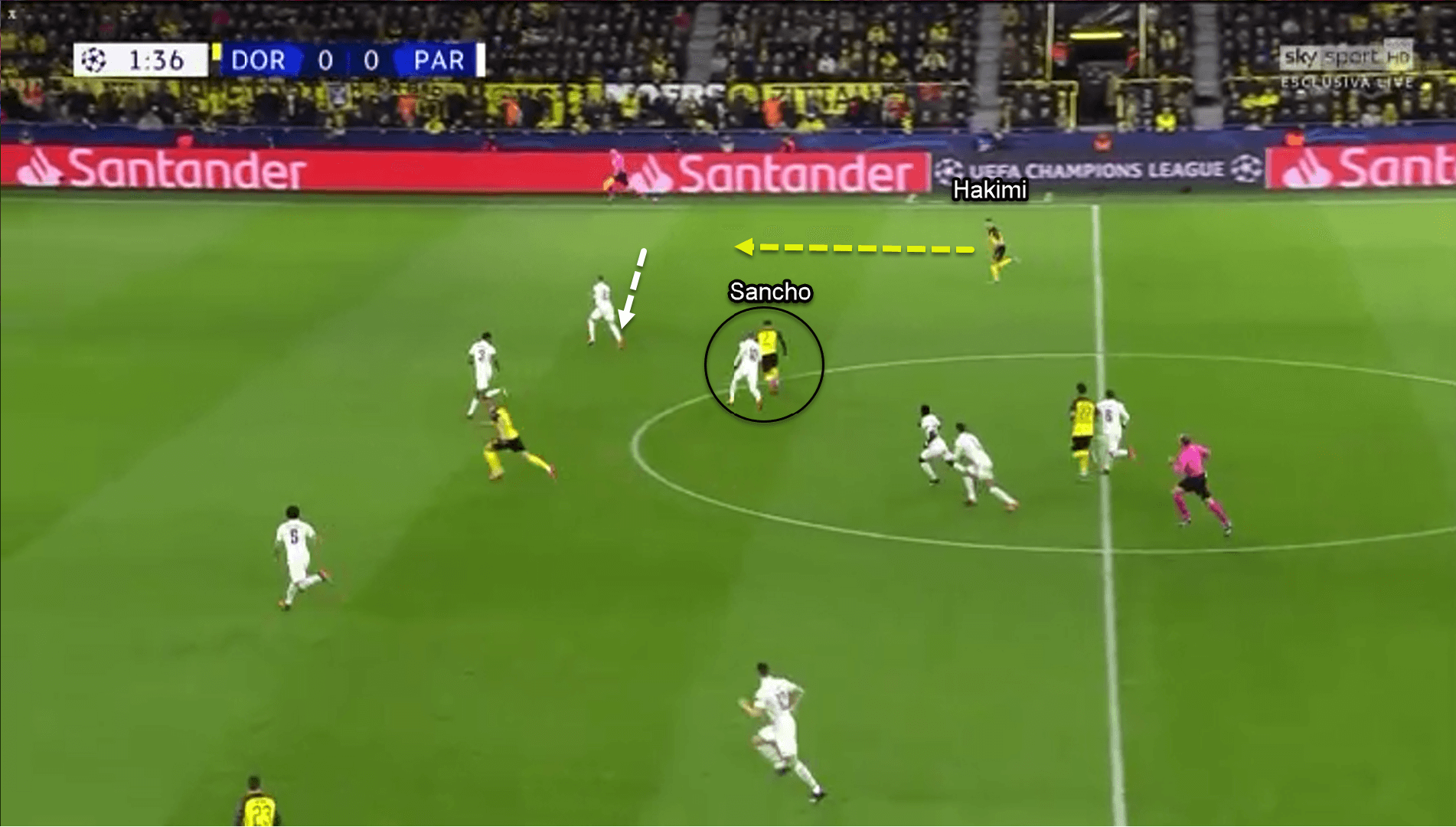
One benefit that Wan Bissaka would gain by having Sancho in front of him would be the positioning that the winger has, this is shown in the image above. With his preference dropping into the half-spaces; he will likely drag the opposition fullback inside due to the danger he creates against the opposition when he has the ball. This makes space for Hakimi, the fullback, to overlap on the right. This would mean Wan-Bissaka would have more space in the wide areas to make progressive runs and dribble at defenders, both of which he is good at, as shown beforehand.
However, Hakimi is one of the best attacking fullbacks in Europe at only 21 years of age and complements Sancho very well with his speed and overlapping runs which have helped the right-back to 10 Bundesliga assists this campaign. Like I mentioned beforehand, Wan-Bissaka is sometimes hesitant in his forward runs and this means he does not operate as much in dangerous positions as Hakimi does. Wan-Bissaka would certainly need to improve in this aspect otherwise he would hinder Sancho’s performance too, as he would not have a forward passing option out wide when he has the ball in the half-spaces like above.
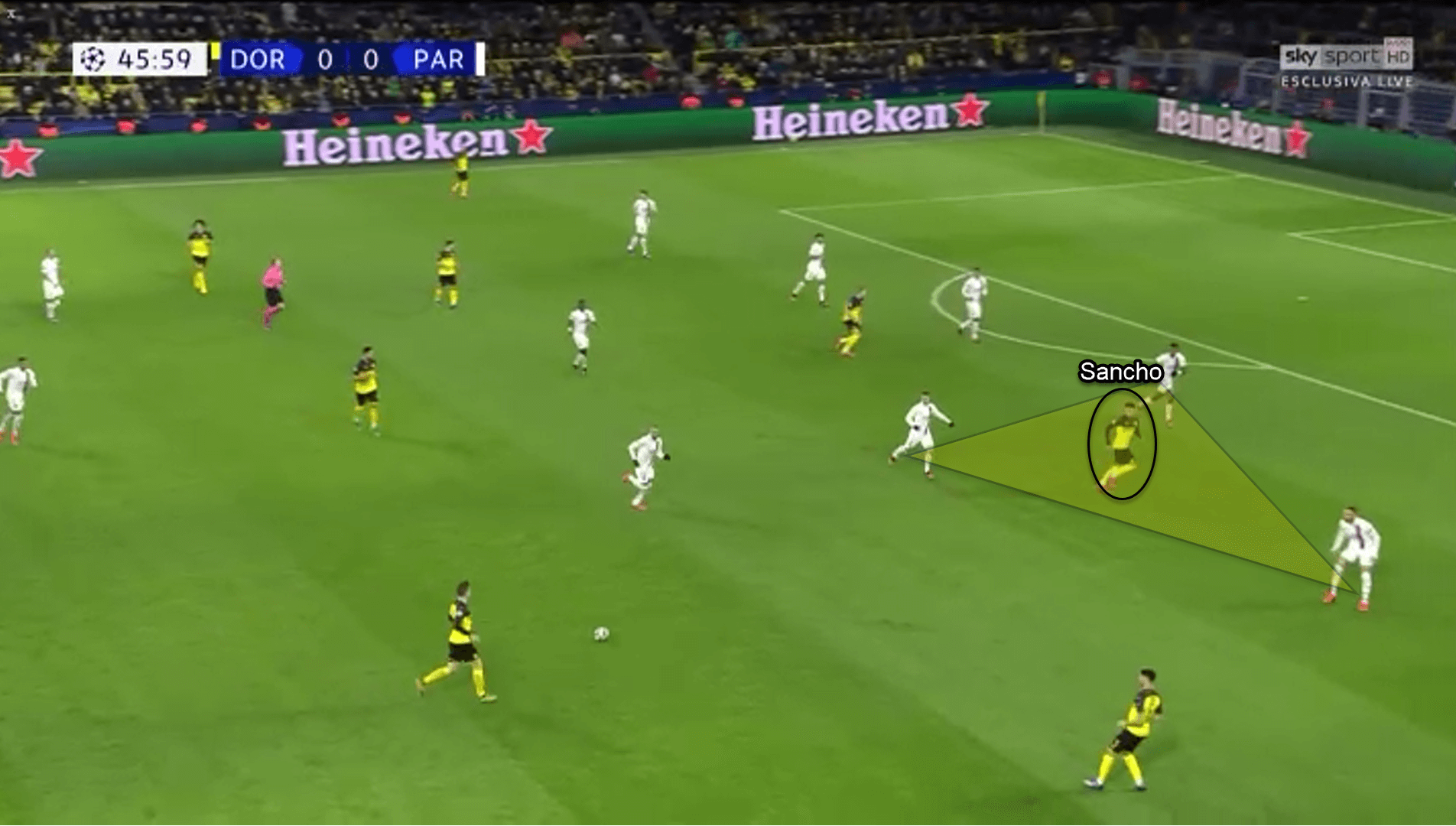
The positioning of Sancho would also mean that Wan Bissaka would be able to play more of his prefered passes into the inside areas, as Sancho likes operate in the half-spaces as shown in the image above where Sancho has found a pocket of space in between three opposition players in the half-space.
As well, Wan Bisska would find link-up play with Sancho on the right flank much easier than with any of United’s current wingers as Sancho’s positioning and movement allows one-twos to be executed much more. This could get the full-back into much more dangerous positions on the wing to cross and would likely result in more assists for the right-back. Here is a comparison of positions that Sancho finds to help with link-up play to the positions that United wingers offer Wan-Bissaka during link-up at the moment.

On the left, Greenwood has moved into space where it is near impossible for Wan Bissaka to link-up with him at all. The position he is in has an opposition player blocking the passing lane. I have highlighted a better position for Greenwood to be in which would offer Wan-Bissaka an open pass and potential for a one-two.
On the right shows the contrast with Sancho, where he is in a good position to receive the initial pass from Hakimi and then has the ability to play the return pass over the top of the opposition defence.
The example helps explain why Wan-Bissaka averages only 2.91 crosses per 90 through the whole season but the tactics of Ole Gunnar Solskjaer must also be taken into consideration, as Manchester United as a whole only complete 13.47 crosses per 90, whereas a team like Liverpool complete 20.75 per 90.
Wan-Bissaka’s link-up play with the winger would also be much better with Sancho due to the quality of passing and vision that the Dortmund player has. This season, Sancho has an xA of 0.31 per 90 but is creating a staggering 0.71 assists per 90. Although this kind of overperformance cannot be sustained, it still shows the quality of pass that Sancho can produce. Even when the right-winger at Manchester United is positioned well, it is not a given that they have the vision or capability of making the pass to Wan-Bissaka on an overlap. A comparison of Sancho’s vision and passing ability against what is offered on the wing currently in front of Wan-Bissaka is shown below.

On the left, Wan-Bissaka has made the initial pass to Greenwood, who is found in positive space which the United wingers do not find enough. However, when he gets the ball Greenwood does not have the vision to find Wan-Bissaka who has carried on his run with a great overlap. Instead, Greenwood takes the ball on the inside.
Whereas, the right image shows Sancho’s ability and vision. After being passed the ball by Hakimi, Sancho can see the run from the full-back and plays a perfect return pass beyond the defence while being surrounded by the opposition. He not only has the vision but also can execute these passes at a higher rate than most players in Europe.
However, further improvement in Wan-Bissaka’s balance will need to occur if he is going to continue to be the primary crosser on the right side. Sancho would play the role of the creator and would likely not cross as much as he prefers to dribble inside with the ball or play a pass through, he only averages 1.68 crosses per 90 this season in Germany.
Conclusion
From the analysis above it is clear that the introduction of a winger like Jadon Sancho would benefit Aaron Wan-Bissaka hugely in an offensive sense. Wan-Bissaka would mainly be aided by better passing ability and positioning from the winger in front and it is evident through the analysis shown that Sancho is second-to-none in both of those departments.
Although other potential options from the wing would likely not operate as efficiently as Sancho would, most top-class right-wingers would still offer the clear benefits shown with positional awareness, vision and quality on the ball.
However, this would not automatically increase the right-backs offensive output and he still needs to improve his own game as well for this to occur. Though, it is important to remember that he is 22-years-old and is having only his second full season of professional football. His strengths will develop further and he will be able to improve on his weaknesses but the help of a right-winger (that Manchester United have needed since Luis Nani left the club in 2014) will also aid Aaron Wan-Bissaka in his offensive output.

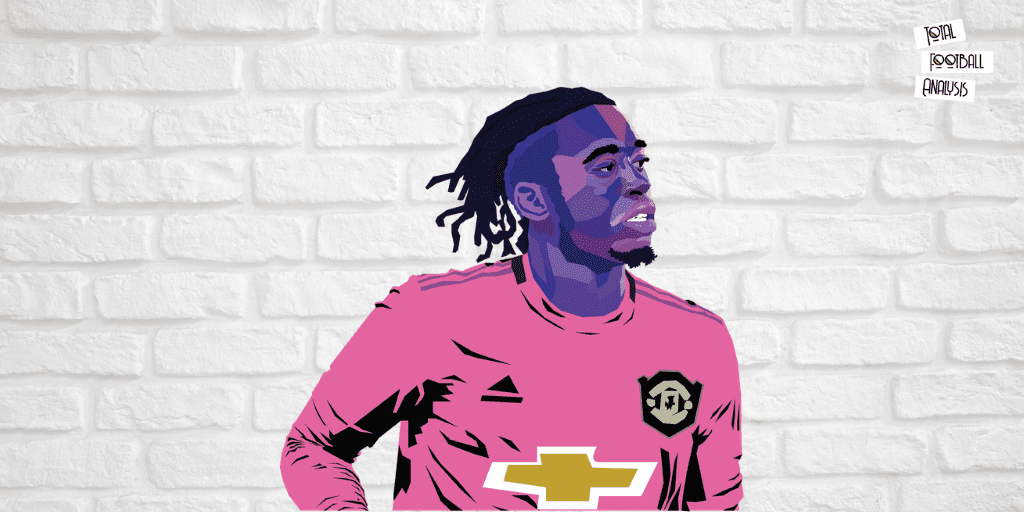



Comments